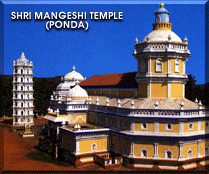

Beyond the beaches of Goa are a wealth of interesting sights, both man-made and natural. Most places, with the exception of the Dudhsaghar Waterfalls, are within easy reach of the coast and on main transport routes.
The Goa Tourism Department has a number of conducted sigtseeing tours and river cruises that cover almost the whole of the state. There is a free booklet (The Goa Tourist Directory) with up to date information on all these tours which is available from all tourist offices. There are tourist Information Centres in the following towns: Panaji, Margao, Vasco da Gama and Dabolim (Airport). Furthermore there are local voluntary offices in Calangute, Candolim and Colva.





During the early years of the Portugese occupation of Goa, a policy of compulsory conversion to catholicism was followed and most of the temples and mosques were destroyed. Certain areas, such as Ponda Taluka, which didnt come under Portugese control until much later, were spared and many of their old temples are still standing. The following are a few of the more important temples of Goa:
About 1km south is the Shri Mahalsa Temple and further south near Velinga, The Shri Laxmi Temple. To the west of Ponda , near the villages of Bandora and Queula are the temples of Shri Nagesh, Shri Ramnath, Shri Mahalaxmi and Shri Shantadurga. 10km north of Ponda at Savoi-Verem, not far from the Mandovi, is the Anant Devasthan Temple. A further 8km leads to The Ganesh Temple, near Candola. East of Ponda, on the main road to Bangalore, is The Kudamba Temple.
Just outside Ponda, on the north east side is The Safa Shahouri Mosque. Today there are only two remaining ancient mosques in Goa. The other is the recently renovated Namazgah Mosque near Bicholim.

Though every town in Goa has a church and numerous chapels, a few older examples stand out and are worthy of mention (and a visit). By far the largest concentration of superbly preserved, beautiful, old churches is to be found in Old Goa (see map). The following are also of some importance architecturally and historically:
Our Lady of the Immaculate Conception (1619): This Renaissance style building, featured above, is probably the best known landmark in the capital (see Panaji map).
Our Lady Mother of God (1873): This Neo-Gothic style church is at Saligao (only 4km from Calangute).
Our Lady of Miracles (1674): situated approximately 2km east of Mapusa.
Church of the Holy Spirit (1675): see Margao map.
Saint Andrews Church: see Vasco da Gama map.
Pilar Seminary (1613): situated close to Goa Velha, 9km south east of Panaji.
Rachol Seminary(1580): situated above the Zuari River, 6km from Margao.
FORTS:
Besides the coastal forts of Tiracol, Chapora, Aguada, Mormugao, Reis Magos and Cabo de Rama there are also three others inland: the Alorna Fort (on the Chapora River near the border with Maharashtra), the Corjuem Fort (on the east side of Bardez Taluka ) and the Nanus Fort (near Valpoi in Satari Taluka ).
MUSEUMS:
The State Museum of Goa (see Panaji map). The Archaeological Museum (see Old Goa map).
WILDLIFE SANTUARIES:
The Salim Ali Bird Sanctuary is located at the western tip of Chorao Island in the Mandovi estuary close to Panaji. Easiest access is via the ferry from Ribandar, 5km east of Panaji on the road to Old Goa.
The Bondla Sanctuary, though small, is apparently the best for seeing all sorts of wildlife. It is situated near the village of Tisk on the road from Ponda to Bangalore.
The Baghwan Mahaveer Sanctuary is on the same road but closer to the town of Molem. Nearby are the Tamdi Surla Temple and the Dudhsagar Waterfalls.
The Cotigao Sanctuary is in the far south of the state in Canacona Taluka, not far from National Highway 17.